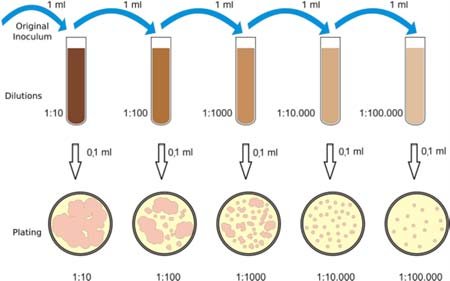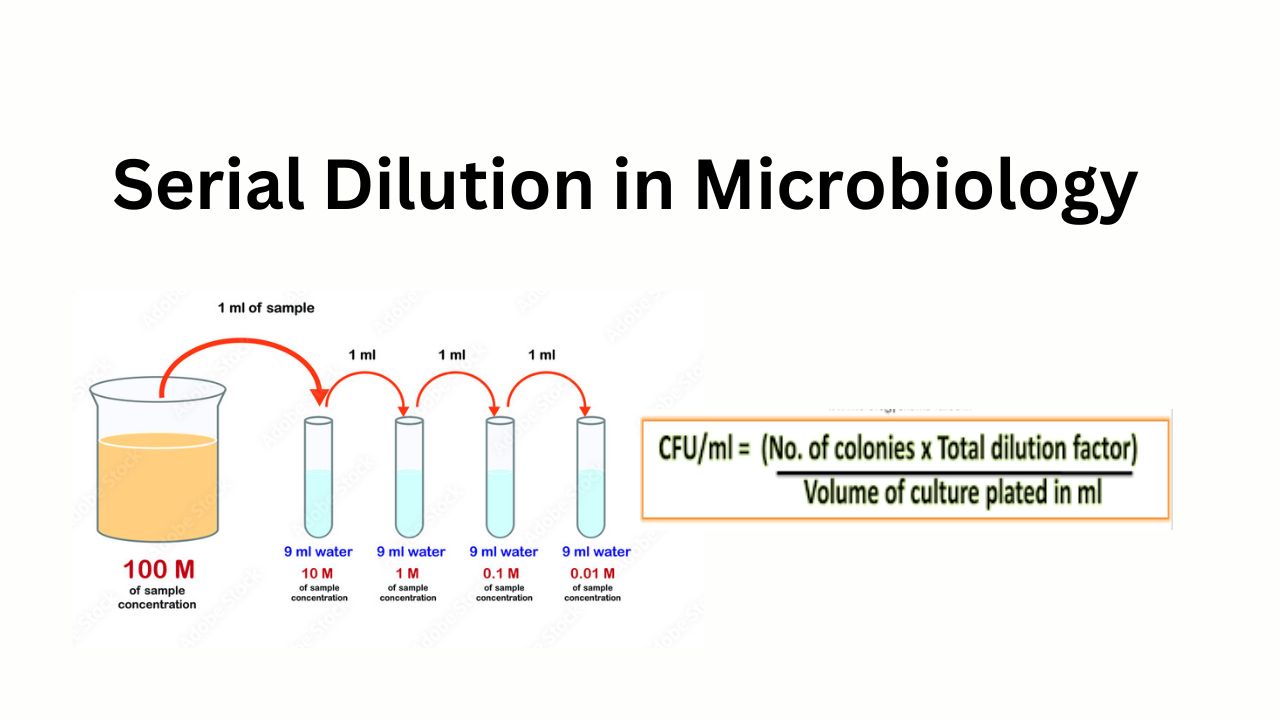Serial Dilution is most commonly used in the Microbiology laboratory to reduce microbial concentration through a successive dilution of a sample in a fixed volume of liquid diluent or Saline solution. In this article, we will cover how to do serial dilution and their calculation in the Microbiology Laboratory
What is serial Dilution in Microbiology?
Serial Dilution is the most common practice to determine the microbial counts for both liquid and solid specimens. Most specimens have a high enough number of microorganisms its almost impossible to CFU count in cultural plates that’s why the specimens have to be diluted to reduce their microbial cell concentration to quantify effectively
Why we do Serial Dilution?
The standard plate count method is reliable for the enumeration of bacteria and fungi. We know that the common practice of Bacterial CFU count is first we mix the specimen or sample in a saline solution then dilute the sample and pour it into an agar plate, the agar solidifies with the bacterial cell and is locked inside the colonies that appear within the agar and as well as top of the agar and below the agar we can easily count bacteria.
We know that the Culture techniques require liquid suspension, if someone brings a solid sample such as powder, or table, it is impossible to do culture practice without diluting to a normal saline solution and if the concentration of organism is very high in the sample then it is impossible to count colonies. we know that the standard Colony forming unit (CFU) of bacterial culture ideally uses a colony count limit between 30 to 300 Colonies. More than 300 colonies were considered Too numerous to Count (TNTC) and colonies of fewer than 30 colonies were considered Too few to count (TFTC)
Importance of Serial Dilution in Microbiology
In Microbiology, the importance of serial dilution is to decrease the microbial cell concentration to the required concentration for specific test methods or the cell concentration to which is easier to count colonies in a cultural plate
How to do Serial Dilution?

Serial Dilution in Microbiology Step-by-Step
- Step-1: Transfer 1g or 1 ml of specimen or sample into 9ml of normal saline solution dilution to become 101 solution
- Step 2: Transfer 1 ml of 101 solution to the next tube which contains 9 ml of saline solution and it becomes 102 Solution
- Step 3: Repeat this process for successive dilution and it becomes 103, 104 and so on
- Step-4: Aseptically transfer 0.1 ml of dilution sample to the culture place according to specific test requirements
How to Calculate Serial Dilution in Microbiology?
For calculation, First, we need to know the Dilution Factors and CFU/ml formula
Dilution Factor: The amount of Specimen transfer is divided by the total volume after the transfer
Example: In the first tube, we transfer 1 ml of the specimen to 9 ml of saline solution its dilution factor is 1/10 or 101 similarly in the next tube dilution factor is 1/100 or 102 and so on.
Formula of Colony Forming Unit (CFU)/ ml

For Example
- No. of colonies=63
- Total dilution factor=103
- Volume plated=0.1ml ( we transfer 0.1 ml of diluted solution into culture plate)
CFU/ml in original Stock =63 ×103 / 0.1 ml = 63 ×104 =6.3×105 CFU/ml
Advantages of serial Dilution in Microbiology
- Serial dilution allows us to reduce the concentration of microorganisms in the specific test methods which is suitable for analysis
- Serial dilution is often used for the enumeration of bacteria in a sample. For solid samples, serial dilution is the only way to grow the microorganism in an agar plate
- It helps in achieving a more uniform distribution of microorganisms when spreading on solid media, ensuring that individual colonies can be isolated and counted accurately.
Disadvantages of Serial Dilution in Microbiology
- Higher Risk of contamination, serial dilution involves a series of dilution processes it may contaminated if it is not handled carefully
- Required expert person who can use micro-pipette with accuracy
- Chance of Dilution error
- If the sample is diluted too much it becomes very difficult to recover the viable cells
Conclusion
In conclusion, serial dilution is a fundamental technique in the microbiology laboratory that serves multiple purposes, ranging from adjusting the concentration of microbial samples to enabling the accurate counting of viable cells. This stepwise dilution process provides researchers with a practical means of obtaining a range of concentrations for experimental studies, particularly in the determination of viable cell counts and the assessment of microbial responses to various conditions
